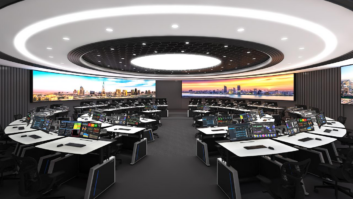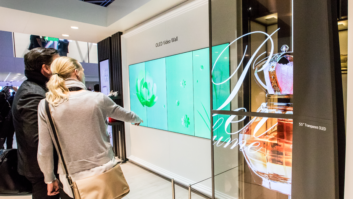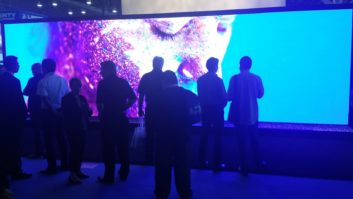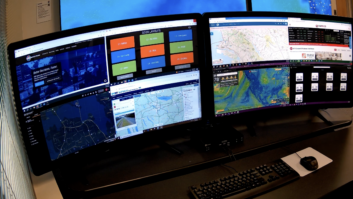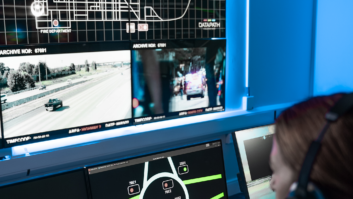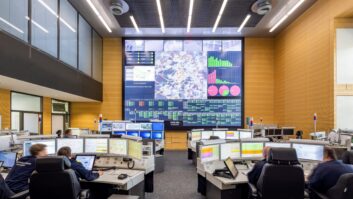A challenge that faces every part of the audiovisual industry is the increasing commoditisation of the products it offers. It doesn’t seem long ago, for example, that the installation of any projector was a job that would be handled by a professional, however it is no longer beyond the ability of the end user. Similarly, anyone who has a PC and a webcam can now set up an audioconference or a videoconference.
What has been interesting has been to see how the industry has reacted. In the former case, projector manufacturers have embraced the idea of ease of use: given the increasing parity in key performance metrics such as brightness, resolution and contrast ratio, ease of use has become an important differentiator. In audio- and videoconferencing, the industry has focused on delivering a quality of experience and flexibility that no PC-based system can begin to offer.
But what of the control rooms market? To the untrained eye, a control room looks very much like it consists of rows of displays attached to smart graphics cards and, beyond that, to a network of sensors. Is there a danger of this too becoming a commodity market in which differentiation is increasingly difficult to achieve – and if there is, what is the industry doing about it?
Special projects
In some cases, the industry bristles at the thought that anyone might see its offering as in any sense a commodity – or even approaching it. For a start, control rooms are one of the most demanding audiovisual applications. Eric Hénique is director of marketing and international sales at eyevis.
“The hardware for control rooms is very special equipment because it is used in 24/7 operation,” he points out. “This means that you can’t use standard hardware – you need special reliable hardware with particular features for non-stop operation. A display is not just a display, for example – it needs to be built with components, use technologies and have redundancy features that can deliver on that requirement.”
Robert Wu, senior director of market strategy at Barco, sees some degree of commoditisation. “Yes,” he says, “for traditional solutions, it is very difficult to differentiate purely based on hardware as there are more and more options available. But if you look at today’s increasingly sophisticated, network-centric environments, there is significant scope for software, services and the addition of application-specific features.”
At the other end of the scale is Luca De Lorenzo, who is director, EMEA control room sales for Planar Systems. “While hardware remains the most important aspect of the control room, the core differentiations between manufacturers regarding value-added services are still not easily recognised. For years, Planar has been positioned to offer turnkey solutions, bringing that critical added value. We support an easy and seamless integration between the Planar solution offered and the end user/system integrators’ applications.”
The important consideration for many customers is not the individual elements of the control room solution, but the whole proposal, according to Steve Murphy, managing director of eyevis UK, the exclusive distributor for eyevis in the UK and Canada.
“Once the client sees the value of the integrated solution, it opens their mind to the additional functionality that the display wall system can bring,” he says. “For example, the ability to automatically change display layouts via external alarms, remote viewing of control room applications using the display wall function, and automatic recording of display wall content under specific alarm conditions.”
Mike Garrido, product manager for Multiviewers at Harris Broadcast Communications (which took over Zandar’s control rooms business), puts it succinctly. “In general, all manufacturers look for ways to differentiate,” he says, “but the real key is having a difference that offers true value to the end user – and that’s something that can be obtained only through understanding the customer’s needs and processes.”
So what are those differences that offer true value to the customer? For a start, while companies such as Barco, eyevis, Harris and Planar may appear to be hardware vendors, their product offering is at least as much about software as it is about hardware. “Our value added lies in providing the complete solution – delivering a control room platform to the end user rather than just a product,” says Wu.
“That platform consists of hardware and software at its core, and it allows innovative and open ways of delivering new services and support. A simple example is to deliver intelligent products that can be managed remotely via standard networking protocols already deployed in the industry.”
Software also plays a vital role in interoperability, as Hénique points out. “Systems in control rooms have to be compatible not only with standard systems, such as those from AMX and Crestron,” he says, “but also with other software systems like the control systems of ABB, Siemens, Honeywell, Yokogawa and Emerson, as well as with other management systems such as Seetec, Advancis, Milestones and so on. For this reason, our control room manager software, eyecon, has full API capability and customers can benefit from this open interface. Added-value software solutions make the work of the control room team easier and reduce reaction times or the risk of mis-operation.”
Supporting role
And not only should the base platform be interoperable but, as Garrido points out, support personnel should also be familiar with those products that are commonly found in installations, not just their own offerings. “Support people should know their way around a control room,” he says.
And beyond software there is, increasingly, a range of services that customers can access. This is the area in which the industry provides perhaps its most significant added value – and, while there is much common ground, there are also inevitably differences between customers.
“New customers primarily value consultancy and design to ensure that the technology fits their operational procedures and needs,” notes Wu. “Established customers, on the other hand – those who already have control rooms – place the most value on things like warranty and preventative maintenance to ensure 100% availability and quick repair times.”
Being able to advise on best practice in control room design is certainly an area in which the industry adds value. “We work very closely with our systems integrator partners at a very early stage of the project. This enables us to make a detailed analysis of the end-client requirements in terms of the control room layout, operator positions, ergonomics, sources for display and the control and integration requirements,” notes Murphy. “This then allows us to ensure a best-fit solution is offered within the available budget.”
Hénique agrees. “Control room design is becoming more important,” he says, “not only because, increasingly, control centres are becoming the heart of an operation – but also because they’re a showcase.”
Both Murphy and Hénique note the importance of ergonomics, and the value that a manufacturer can bring in supporting the efforts of systems integrators. De Lorenzo sees the same thing. “In 2005, Planar created the Control Room Provider (CRP) department, which provides consulting services to key customers who want to renew/upgrade or build new control rooms,” he says.
“The CRP team takes into consideration operators’ ergonomics and the overall visual impact of the control room. Then, taking into account European regulations and standards, we can propose which displays should be used, how the consoles should be designed, the optimum lighting and so on.”
Without exception, manufacturers and distributors expect to work closely with their systems integration channel. “With our integrators, we work hand-in-hand from the design to the acceptance of the project,” says Hénique. “We also provide training programmes, and transfer our know-how regarding the technology and the systems so that integrators can offer the best possible service and maintenance to their clients. The best products are nothing without good, fast service.”
“We act as a ‘system integrator to system integrators’,” says Murphy, “managing for them all aspects of the display wall system. This includes specifying, procurement, delivery, installation, commissioning, integration to external systems and assisting with long-term support. We are also heavily involved in the sales process with our system integration partners.”
That closeness is something that Fabrizio Rossi, of integrator sis.temi, appreciates. He especially values having access to a broad, flexible product range, good spares availability and responsive, professional technical support – but that’s not all.
“Sometimes,” he says, “you need your supplier’s help in convincing a customer that what he wants is unrealistic. And sometimes, it can be very helpful if your supplier can work with you to tell your customer that we just don’t have a solution for his problem.”
The key often lies in establishing an appropriate ‘who does what’ relationship. Wu explains: “We will always try to work with integrators to ensure that the manufacturer’s services and warranties are integrated into the services and support that the integrator provides,” he says. “With proper integrator and consultant partnerships, we ensure that the services and capabilities that we can offer are packaged properly for the consumption of each individual end user.”
And that’s the nub of it. There is no single control room marketplace – because each customer’s requirement is unique: there can be no ‘one-size-fits-all’ approach. “In the control room market, you have to be flexible,” says Hénique. “The requirements of the customer are various and you can’t work with standard off-the-shelf products. Also, you have to offer special solutions or, for some areas, especially certified products that comply with certain market/business-specific requirements.”
“I would estimate that 99% of our offers are customised solutions,” says De Lorenzo. “Our product range gives us huge flexibility in terms of features and configurations. We have a pool of sales and technical sales staff who are fully engaged with potential customers to define and develop tailored solutions.”
“We ensure fit for the customer in a number of ways,” notes Wu. “For example, we dedicate market-specific resources or experts that are engaged within each market to ensure that we have understood the proper requirements and how to deliver that capability to the market. We also follow a platform-based strategy in the development of our products.”
Rare commodity
That idea of a platform-based approach is about as close to commodity products as the control room industry gets – and it’s really not that close. Garrido develops the theme. “With a platform-based approach, it’s possible to meet the requirements that are shared among many customers,” he says.
“Some examples of shared requirements are reliability, ease of use and low cost. As a manufacturer, we look to satisfy those shared requirements – and then build market- or customer-specific requirements on top.”
It fills Greg Jeffreys, managing director of Paradigm, with awe. “We just make high-quality displays,” he says, “and then our partners add their fairy dust.” Taking a standard product such as a display and turning it into something that is uniquely suited to the needs of the control room market involves the use of specific technologies and components, the application of integration expertise, the provision of software and interfaces, the delivery of consultancy services, the availability of extended support and service, and the close working relationship between manufacturer and integrator. These are all value added by the industry and ensure that, appropriately marketed and sold, it will avoid becoming a commodity market. That’s the ‘fairy dust’.
“We see our main challenges, including supporting the existing close relationships we have with systems integrators and associated control room partners, as continuing our product development to maintain the level of differentiation that we currently have,” says Murphy. “For example, continuing the integration of more and more manufacturers’ IP video streams into our IP video-decoding cards and implementing more interfaces to ‘popular’ third-party control room applications.”
“We have seen a change in the control room market and, as a result, we began to incorporate more service and engineering efforts,” concludes De Lorenzo. “We expect service and engineering needs for control room projects will be an even more important part of the total project in the future.”
Challenges ahead
And therein lies one of the tests the industry faces – a point made by Garrido. “The biggest challenge is customer perception,” he says. “How the customer sees our business is critical for continued growth. If we fail to promote the software and services we provide, and all customers see are products – business is lost.”
It all reminds me of a lesson I learned many years ago when I was a fresh-faced salesman for a computer company. I had just completed a course designed to help us understand our new intelligent terminal and, when my account manager took me out to meet a major mainframe prospect, I was determined to show off my newly acquired knowledge.
To cut a long story short, we won the deal and, as we did whether we won or lost, we enlisted the help of the customer in understanding why. “Your proposal was very similar to those from IBM and Hewlett-Packard,” he said, “but what we really liked was the fact that your intelligent terminal could scroll information.” We were amazed. Both IBM’s and Hewlett-Packard’s intelligent terminals could do exactly the same. But then we realised: to those companies, scrolling was a commodity feature – so they hadn’t bothered to demonstrate it. We had, inadvertently, created differentiation where none truly existed.
That’s the power of salesmanship. There is, however, unquestionably differentiation in the various manufacturers’ hardware offerings for the control room market – but it is not always immediately clear. While, inevitably, there is some degree of commonality in the underlying hardware, there are also important differences – and manufacturers and integrators alike are further enhancing that differentiation with added-value software, services and support.
The key to success lies in three areas. The first is having an in-depth knowledge of the hardware and software platform, its capabilities and, more importantly, how those capabilities are different from – and better than – those of competing products. The second is developing a detailed understanding of each customer’s needs. And the third? The third is articulating that differentiation and competitive advantage in a way that responds to those needs.
Which reminds me of something else I was taught at sales training school. In any discussion of differentiation and competitive advantage, it can be difficult to understand why customers choose an apparently inferior solution. The hard fact is, however, that the best solution doesn’t always win – but the best salesman always does.
